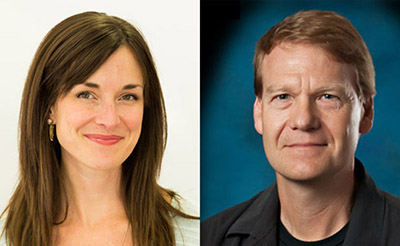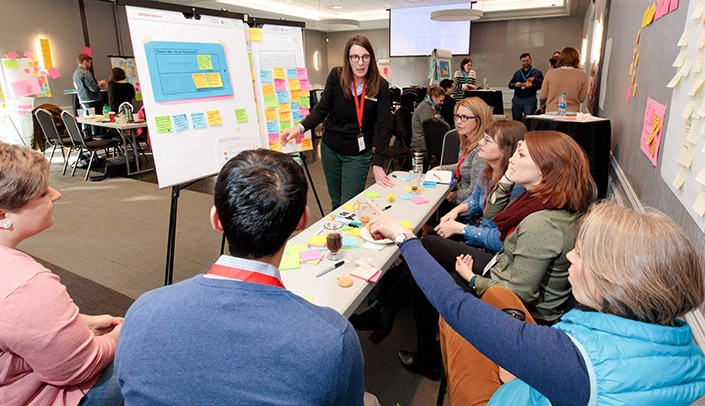When UNMC holds this week’s Design Thinking Boot Camp, it will only be the latest in a series of efforts the university is making as it seeks to incorporate design thinking throughout the UNMC community.
This year’s event will focus on a scenario with the Munroe-Meyer Institute and the UNMC College of Dentistry — but the workshop, and design thinking itself, offers a variety of applications for attendees who are interested in developing the skillset of empathy-based problem solving.
 |
From left, speakers Kathryn Segovia, PhD, and Douglas Dietz |
With a small cohort of attendees from UNMC, Nebraska Medicine, UNO and Clarkson College, this year’s workshop is being significantly modified with a “safety first” mindset because of COVID-19. There will be significant de-densifying, use of face masks and shields, regular hand and surface hygiene, virtual interviews of patients and socially distanced in-person activities.
“Two years ago, we decided at UNMC that design thinking was a major strategic initiative for the campus,” said Dele Davies, MD, senior vice chancellor for academic affairs. “I’m delighted to see how it has taken off and the excitement and interest being shown by faculty, students and staff — and how it is already being used for problem solving across the campus and with our community partners.”
“Design thinking is a process that guides you through problem solving with a human-centered lens — for us, that means our patients, faculty and students,” said Jennifer Kallio, DDS, one of the event leaders and assistant professor in the adult restorative department at UNMC College of Dentistry. “When we look at a problem, we take a very humanistic, centered approach to listening to that person and designing for that specific person, which then can be applied to a lot of people in a lot of situations.”
T.J. Welniak, MD, UNMC Department of Emergency Medicine, held a design-thinking exercise for his department in 2019. He had first become aware of the concept, pioneered at Stanford University, as a fellow in 2016, and he was intrigued at its ease of use and flexibility.
“I thought this had a lot of potential for practical application in the health care system and medical education,” he said.
Dr. Welniak is not alone in that belief. The two lead facilitators of the design thinking boot camp — Kathryn Segovia, PhD, director of the design thinking program at Stanford, and Douglas Dietz, principal design thinker for GE Healthcare, also will be speaking as part of the Breakthrough Thinking Conference.
“The conference always has been designed to stimulate people to think about areas that may affect them in one way or another as they’re preparing their strategic planning for the coming year,” said Rowen Zetterman, MD, organizer of the Breakthrough Thinking events. “Design thinking is an approach to learn how to think differently about how you approach problems, look at what the needs are and prepare your planning around that.”
The Interprofessional Academy of Educators (IAE) also is preparing a design-thinking track for its members.
“We’ve presented it to the new members, and we’re getting ready to present it to all the member,” Dr. Kallio said. “The IAE brings together a diverse group, and our hope is that the coaches will be part of IAE and help move that forward here at UNMC.”
Additionally, Amy Pick, PharmD, who will be a coach at the upcoming conference, recently received a grant to use design thinking and journey mapping to look at the student experience in the UNMC College of Pharmacy.
“As educators, sometimes we make a lot of assumptions on what is working well and not working well,” she said. “We’ll make use of comments from an evaluation, but we don’t hear collectively about the experience, and we don’t dive deeper.”
Using design thinking, she said, will allow educators to find themes and transformative moments that matter to students.
“What experiences have really mattered, have made a difference?” she said. “That will help figure out the experience we should offer the students.”
Katherine Bravo, PhD, of the College of Nursing trained at Stanford in design thinking, as well.
“The techniques that we learned at that workshop, we were tasked with bringing back to UNMC,” she said. “We were looking at ways to use the skills that we learned right away, put them into practice.”
“As it’s continued to evolve, we’re blending what we learned in those workshops with the continued interaction of the Stanford personnel, to try to implement it and blend it with our own culture here at UNMC,” Dr. Bravo said.
“We need to create this broader understanding about what design thinking can lend to the university, as well as getting buy-in from point people who can either give the time, effort or encouragement to others.”
“The beauty of this is that everyone can apply it,” Dr. Welniak said. “The workshops create a cadre of staff, faculty and employees who are champions in this area, and then they become change agents themselves.”
To learn more about design thinking, click here.
